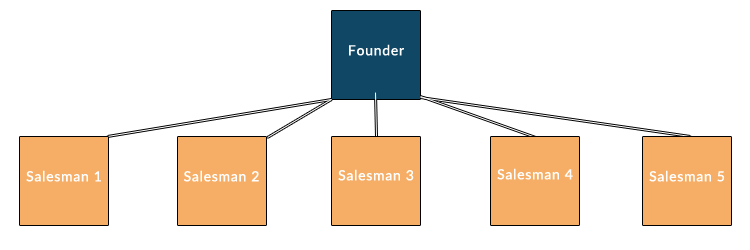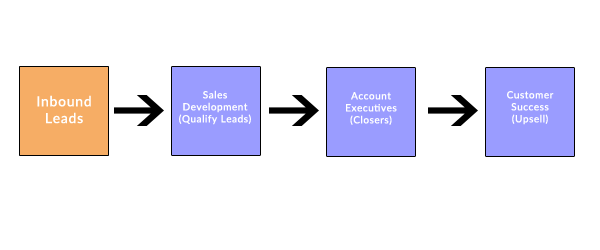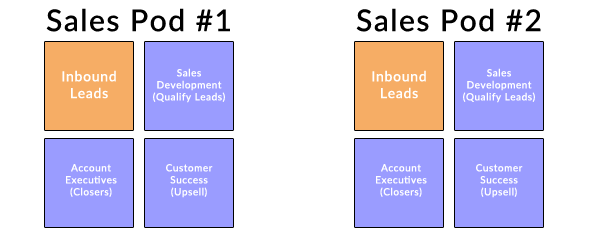Sales are the lifeblood of any business. For startups, there are few things more difficult than hiring your first sales reps to push your product. Building a sales team takes a lot of work and some trust on the part of the founder. Most founders act as the head sales rep in the early days of their company. Some hold onto the position longer than others. But, handing off that duty, the most central duty to the growth of the company in its infancy — can be a hard task.
Most companies start small, bringing on a single sales rep or two to help reduce some of the load on the founder’s shoulders. However, once those reps find their footing, things can quickly scale. Without a defined structure in place, your sales team will not reach its peak effectiveness, leaving money on the table.
Organimi provides the perfect platform for mapping and structuring your startup’s sales team. Because your team will be constantly growing, shrinking, and changing — the ability to edit your sales team chart and keep it consistently updated is an important feature.
Let’s start by taking a look at some of the more common startup sales team structures:
The Island Sales Team Structure

Most companies that are hiring their first sales reps are likely to start out with the Island sales team structure. For most companies, the founder acts as the head salesperson in the early days of the business. When they’ve grown to a level that he can begin passing off that duty to others, they will likely report directly to the founder until the system and department are in place and a manager can be hired to run the team.
In the Island sales team structure, each sales rep is typically left to themselves and is responsible for all activities within the sales process. This includes generating leads, qualifying them, nurturing them, and closing the sale. It is a lot on the plate of each individual rep, and for most companies is not a sustainable model for a growing sales team.
There are some benefits to the Island structure though. To start, it allows founders to stay directly involved in a sales process that they are not completely ready to step out of yet. Additionally, the disconnected nature of the team facilitates competition among the sales reps and often leads to higher sales numbers. However, it is important to keep a close eye on your team and ensure that the competition between sales reps remains positive and healthy.
The Island sales team structure is not an ideal one for businesses that have grown to the point of hiring more than a handful of reps, but for a budding startup, it can be a great way to get your foot in the door and remove some of the sales responsibility from the founder.
The Assembly Line Sales Team Structure
 The Assembly Line structure is the go-to sales structure for small and mid-sized companies. It is also very popular among SaaS startups. In the most basic sense, the strategy breaks down the sales process into individual tasks. Then, people are hired to handle each individual task. These tasks often include but are not limited to:
The Assembly Line structure is the go-to sales structure for small and mid-sized companies. It is also very popular among SaaS startups. In the most basic sense, the strategy breaks down the sales process into individual tasks. Then, people are hired to handle each individual task. These tasks often include but are not limited to:
- Lead generation team. This team is responsible for generating leads, hunting down information, creating some initial research materials about each prospect, and organizing the data in a way that is easy to understand and sift through.
- Sales development team. This team is in charge of using the initial research and conducting their own research to qualify the leads that the team has gathered. Every team operates differently, but your sales development team may give the prospect a call and ask a few quick questions if they are unable to qualify them through another avenue. Once qualified, they are passed to the account executive team.
- Account executive team. The account executive team is responsible for closing the sale. They are typically responsible for demoing the product, responding to concerns, and doing the back-and-forth that is required to nurture those prospects toward the sale. Then, once the sale is closed, they are passed to the customer success team.
- Customer success team. Once your prospect has made the purchase and becomes a customer, you want to make sure that they stay on board and find value in your product. They should be connecting with your customers often.
The Assembly Line is a great choice for startups. It creates a low-stress environment where every person has a very specific job to do. As you grow, you can examine your roles and find new ways to deviate from the example while still keeping the spirit of the strategy in-tact.
The Pod Sales Team Structure

The Pod structure is very similar to the assembly line and is often employed by growing companies. This strategy is great for creating smaller, tightly-knit teams that work effectively with each other. Each individual pod consists of a smaller “Assembly Line” that works with their own batches of leads.
The Pod sales team structure is also excellent at creating competition between the teams. Teams will work to close more deals than others, and it can make for a really fun environment when it is implemented and monitored correctly.
Although this structure might not be ideal for small companies that are just hiring their first sales reps, it does make for a natural choice after the Assembly Line structure. As your team grows, you can separate your teams off into individual Pods. Each pod can serve as its own testing ground for new strategies that can be shared with the other teams to improve success.
Using Organimi to Map Your Sales Team Structure
When deciding which sales team structure you would like to use in your business, you’ll need a solution for mapping it out. You want to make sure that you have a visual representation of how the team operates and who each person reports to so that you can implement new processes effectively.
Organimi is the perfect solution for mapping out your sales team because it allows you to share the chart internally, edit it as you see fit, and quickly add new team members to the chart as you hire them.
Hiring your first sales reps can be a daunting task. But, going into it with a structure and strategy in mind can make the process easier for everyone involved.

